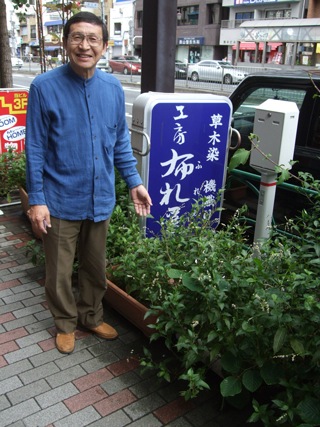- COP10 sees “Fast progress in ‘Agricultural Biodiversity'” it says here.
- Sunflower weeds in Europe derived from crop-wild relative matings.
- Heritage meat and wheat to eat. In Tucson, Arizona.
- Top 10 Men With Salad Names.
Nibbles: Studentship, Cowpeas, Chocolate, Quinoa, Rice in Madagascar, Jackfruit, Wheat breeding, Indian diversity
- PhD student from East Africa wanted to study greenhouse gases, biochar and other cool stuff.
- Weevils eat half the cowpea harvest. Solution in the bag.
- Ecuadorian chocolate experts visit the World Bank. Did they bring samples?
- Lots of ecdysteroids in quinoa. Not clear to me if this is good or bad.
- Yes, Malagasy rice is different.
- Evaluating a Dang Rasimi jackfruit. Looks pretty good to me.
- Crop wild relatives in genebanks help with drought tolerance in wheat.
- Meta-paper on livelihoods diversity in rice-wheat-livestock systems Indo-Gangetic Plains has no room for varietal diversity in rice-wheat.
Shades of blue, Tokyo style
The Human Flower Project reports on a DIY indigo-dyeing shop in the heart of Tokyo. A fine idea, for all sorts of reasons. It puts people in touch with a natural, plant-based dye and offers us a chance to talk about agricultural biodiversity and even plant biochemistry.
The Human Flower Project’s page shows a photograph of the source of indigo labelled Polygonum tinctorium, also known as Chinese indigo. I fondly remember visiting an indigo demonstration dyer near Toulouse, in France, that sourced the dye from woad, Isatis tinctoria. And then there’s the Asian (or true, sic) indigo, Indigofera tinctoria. Native American tribes apparently used other legumes closely related to true indigo for their blue dyes.
What they all have in common is the process to get the colour. Young leaves are mashed with water and then encouraged to ferment. That results in a greenish sludge. The fabric is immersed in the sludge and then hung up to dry. As the pigments oxidize, they turn blue, and expert dyers can control the shade of blue by adjusting the duration of the oxidizing step, and other factors. (Loads more information here.)

It struck me that indigo would make a marvellous central topic for one of those the-entire-history-of-the-universe-as-seen-through-a-single-neglected-thing books. There’s revolt and revolution, trade wars, the origins of modern organic chemistry, mercantile colonialism, slavery and rice, and pretty colours. Kew contibuted its model of an indigo factory to the BBC’s history of the world in 100 objects, but the model does not seem to have been the subject of one of those wonderful broadcasts. A pal of mine did a book on madder, another brilliant dye; I couldn’t find anything similar for indigo (although there is plenty of woo). Publishers! I am available.
Nibbles: Amazon agriculture, Livestock conservation, Chestnut redux, COP 10, Stone Age flour
- More on that thing about how the Amazon was once pullulating with people. And why.
- Why conserve livestock genetic resources. And one possible way to do it.
- The American people are bringing back the American chestnut.
- COP-watchers, something to amuse yourselves with if things get dull.
- Even Neanderthals understood the benefits of a diverse diet. Though not, perhaps, of jewellery.
Nibbles: Milk-drinking, Diversity and stability, Indian sheep, Development of the African savannah, Teaching rice, Silk, Diverse diet, Huge phallic inflorescences
- Der Spiegel does its usual impressive number, this time on the Völkerwanderung. Via.
- Diversity and stability in grasslands. Yes, there’s a connection.
- Sheep breeds in India deconstructed.
- The future of the Guinea savannah. Probably not that great.
- IRRI teaches Singaporean cityslickers to grow rice.
- Silk beginning to fade where it was born.
- The diverse benefits of an agrobiodiverse diet. Should someone tell rich Indians?
- Tales of two giant inflorescences. What are the odds?